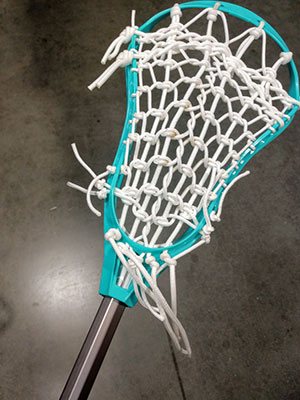Are you looking to get the most out of your lacrosse stick? If so, it's necessary to know how to care for your lacrosse stick.
A neglected stick can lead to a lacrosse stick's performance decline, often rendering it useless.
That's why this blog post will provide an extensive guide on how best to care for your favorite piece of equipment with amazing detail and advice!
From cleaning tips and protective gear information, this fresh look at the topic ensures everyone, from young lacrosse players to professional veterans, can protect their sticks for longer use.
Furthermore, we'll provide top product recommendations specialists swear by that savvy fans swear by. So read ahead as we dive into everything you need to know about the proper care for your beloved lacrosse tool!
More...
Take Away Key Points:
Lacrosse Stick Maintenance Tips
1. Keep your lacrosse stick clean
- In the first place, you should always carefully wipe down your lacrosse stick with a damp cloth and buff it dry with a towel to remove any dirt or debris that can accumulate over time.
- If any visible residue is stuck on the stick, use a soft bristle brush and paper towels to help loosen and remove it.
- Use mild soap and hot water if more stubborn stains must be removed.
- Always keep a backup stick on your property in case of wet conditions, mud, and further damage!
- Before washing the stick, wash only the plastic or wooden parts of the head. The only part that should not get wet is the mesh!

2. Regularly inspect your lacrosse stick
- Check for signs of wear and tear, such as frayed strings or missing laces.
- Check for loose heads that can cause an imbalance when playing or practicing.
- Look for discoloration or damage from sharp objects touching the stick's components.
- Ensure all strings and laces are securely attached and tensioned correctly.
- Ensure that all components are firmly secured and have not become loose over time.
- Perform a regular visual inspection of your playing lacrosse stick every week to ensure it is in good working condition.
3. Replace the shooting strings
Regularly replacing the strings on the head of the lacrosse pocket will ensure performance is maintained at its highest level. In addition, the shooting strings can become worn over time, decreasing accuracy and distance when shooting with the stick.
DIY string job on lacrosse pockets will also help keep the structural integrity of your lacrosse stick intact, ensuring it remains strong and durable for extended periods.
A loose pocket can be a result of two things—either bad weather or poor maintenance of the mesh.
Here are the crucial steps you need to follow to replace your worn-out shooting strings:
- Begin by removing the old shooting strings. Then, gently pull out the strings with needle-nose pliers, a butter knife, or a stringing tool.
- Measure and cut two new pieces of string for each side of the stick head, leaving extra slack for tying knots.
- Insert one end of each piece into the sidewalls of the head and tie a knot at the other end, ensuring that it is tightened enough so it won't come undone during play. Weave the string strands over and under one another using your fingers until you reach the bottom or "throat" of the stick head.
- Tie additional knots at the throat to ensure all loose ends are tucked away safely and securely, then trim any excess material with scissors.
- Finally, adjust the tension of each shooting string to your preference by pulling them slightly taut in opposite directions until you achieve a balanced configuration – this will help maintain optimum performance while protecting both your equipment and yourself from injury risks associated with improperly strung sticks. You can also use a pocket pounder to stretch and create a deeper pocket and looser sidewall strings.
4. Beware of the storage
It is important to properly store your lacrosse stick to keep it in good condition and prevent damage. You can take some simple steps to ensure that your lacrosse stick remains in top-notch shape for years to come.
Always dry off your lacrosse stick after each use and before putting it away. This will help reduce the chances of mildew and other forms of corrosion or damage from forming on the lacrosse heads and handle of the lacrosse stick.
Store your lacrosse stick away from direct sunlight, particularly during prolonged periods such as summer vacation or between seasons. Sunlight can cause fading and other damage over time to certain components of the lacrosse stick.
Storing your lacrosse stick in a climate-controlled area (such as inside) is recommended, as extreme temperatures may cause warping or cracking of the wooden components over time.
Hang your lacrosse stick if possible instead of laying it flat on its side - this will help maintain even pressure on all parts of the lacrosse head and shaft, reducing the risk of bending over time due to an uneven weight distribution when stored horizontally on a flat surface like a shelf or floorboard.
Make sure all protective guards (shoulder pads, elbow pads, etc.) are taken off and stored separately from the lacrosse stick. Otherwise, it could lead to unnecessary wear & tear damage over time if left together for extended periods without being used/played with regularly.

5. Protect it while traveling
Appropriately protecting your lacrosse stick when traveling is essential for avoiding damage and keeping it in good condition.
Here are some tips to help ensure that your lacrosse stick remains safe no matter where you go:
- Invest in a sturdy carrying bag explicitly designed for lacrosse sticks - this will provide the most protection as it will be able to cushion the head & shaft of your stick during transport and reduce the risk of jostling or bumping against other objects.
- Tape up the lacrosse head & shaft with bubble wrap or packing tape for an extra layer of protection - this will help avoid scratches, dings, and other wear & tear damage from bouncing around during travel.
- If traveling by car, secure the lacrosse stick inside with seat belts or bungee cords - this will prevent any sudden movements from tossing your valuable equipment around while in transit.
- Consider investing in protective gear such as shoulder pads and gloves and a lacrosse ball to further safeguard against damage - this can help protect all parts of the lacrosse stick from regular wear & tear and ensure its longevity over time.
- When possible, try to carry your lacrosse stick in person (instead of checking it) - this is especially helpful when traveling by air since baggage handling can cause significant delays in arrival times, which could lead to additional damage if left unchecked on board airplanes or other vehicles/assets!
6. Don't get the lacrosse stick wet!
Getting your lacrosse stick wet can cause significant damage over time if not correctly dried off and taken care of. The main reason is that water can seep into the wooden components of the lacrosse stick, causing warping and cracking, which can significantly weaken the structure of your lacrosse stick.
In addition, sitting water on any part of the lacrosse stick (particularly on wooden components) for extended periods will increase the chances of mildew and other forms of corrosion or damage forming as a result. This can lead to an unpleasant odor, discoloration, and other detriments to both the look & feel of your lacrosse stick.
Suppose you do get the stick wet after a rainy game. In that case, it is important to dry off your lacrosse stick after each use and during longer storage periods to reduce any potential damage due to moisture exposure.
FAQs
Why is my lacrosse stick sticky?
Your lacrosse stick may be sticky due to a buildup of sweat, dirt, and other grime on the handle. Over time, these substances can accumulate and form a sticky film that can cause your hands to become slick when holding the lacrosse stick.
It is important to regularly clean your game lacrosse stick - especially after each use - to avoid this type of buildup.
How long should a lacrosse stick last?
A lacrosse game stick typically lasts anywhere from one to several years and highly depends on how often it is used, how well it is taken care of, and the quality of the materials used.
Good-quality lacrosse sticks made from high-grade material will last longer than those with lower-quality parts. Proper maintenance, such as drying off after each use and regularly checking for any damage or warping, can also help increase its longevity. Additionally, avoiding harsh contact and storage in extreme temperatures or climates can help prevent unnecessary wear & tear over time.
It's always a good idea to have a backup stick as well.

How long is a defense lacrosse stick?
A defense lacrosse stick is typically between 40 and 72 inches long. The player's size largely determines the length of a defense lacrosse stick - taller players usually require longer sticks, while shorter lacrosse players may want to opt for a shorter stick. Depending on the league rules, some levels may also require specific head sizes.
How do you fix a lacrosse stick?
Fixing a lacrosse stick is pretty straightforward, but it requires some basic knowledge and understanding of how it works. Here are some basic steps for fixing your game lacrosse stick:
- Identify the problem: Inspect your stick for any cracks, warps, or breaking points in the material. Depending on the location and severity of the damage, you may be able to fix it yourself or need professional help.
- Prepare to fix: Gather all necessary materials such as clamps, epoxy glue, sandpaper, etc. Make sure everything is clean and free from dirt & debris before beginning repair work.
- Repair: Depending on the specific issue with your lacrosse stick, use appropriate materials to fill any gaps or cracks in the crack and warp-prone areas, such as blades and shafts. Use clamps to secure the repair if needed, and sand away any rough edges when finished. After preparing, let your stick dry completely.
Conclusion
Knowing how to care for your lacrosse stick is essential for maintaining optimal performance. Regular cleaning and simple repair tasks can help keep your equipment in top shape and ensure it lasts for years to come. However, if your stick has done its job, it's time to consider a backup stick.
Properly sized sticks should also be used, as this helps to improve handling on the field and maximize safety. With a few quick steps, you can ensure your lacrosse stick is always ready to go when needed!
